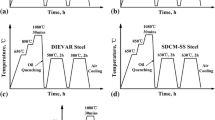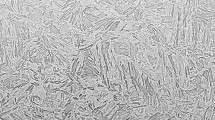Abstract
In the hot stamping process of ultra-high-strength steel sheets, it is a significant issue to reveal the nonuniformity of cooling rate in space–time domain by finite element method and even uncover the inner cause, which contributes to the further adjustment of the phase transformation. In this work, a series of heat transfer experiments between dies and sheets were conducted on the self-developed experimental apparatus. The temperature evolution curves of die and BR1500HS ultra-high-strength steel sheets under different pressures and holding time were obtained. Moreover, the transient heat transfer coefficients (HTC) under different mean interface temperatures and pressures were calculated by the inverse heat transfer algorithm. Subsequently, based on the HTC curves, a thermal–mechanical-phase dynamic coupling finite element model was developed for modeling the hot stamping process, and a series of simulations for analyzing the non-uniform microstructures distribution in hot stamping parts were implemented. Finally, the simulation results were validated by actual hot stamping experiments. Two significant influence factors on the nonuniform distribution of microstructures were summarized as follows: the existence of incomplete contact between steel sheets and dies due to the sheet thickness reduction in sidewall and circular bead regions, and the temperature differences between dies and steel sheets.






















Similar content being viewed by others
References
Karbasian, H., & Tekkaya, A. E. (2010). A review on hot stamping. Journal of Materials Processing Technology, 210(15), 2103–2118.
So, H., et al. (2012). An investigation of the blanking process of the quenchable boron alloyed steel 22MnB5 before and after hot stamping process. Journal of Materials Processing Technology, 212(2), 437–449.
Turetta, A., Bruschi, S., & Ghiotti, A. (2006). Investigation of 22MnB5 formability in hot stamping operations. Journal of Materials Processing Technology, 177(1–3), 396–400.
Merklein, M., Lechler, J., & Geiger, M. (2006). Characterisation of the flow properties of the quenchenable ultra high strength steel 22MnB5. CIRP Annals: Manufacturing Technology, 55(1), 229–232.
Liu, H. S., et al. (2010). Investigation of the hot-stamping process for advanced high-strength steel sheet by numerical simulation. Journal of Materials Engineering and Performance, 19(3), 325–334.
Chen, L. W., Huang, J. M. & Hsu, Y. C. (2015) Investigation of the clinching process combines with hot stamping process for high-strength steel sheets. In 4th International conference on new forming technology (Icnft 2015), Vol. 21.
Hoffmann, H., So, H., & Steinbeiss, H. (2007). Design of hot stamping tools with cooling system. CIRP Annals: Manufacturing Technology, 56(1), 269–272.
Han, X., et al. (2014). Application of hot stamping process by integrating quenching and partitioning heat treatment to improve mechanical properties. Procedia Engineering, 81, 1737–1743.
Ying, X., & Zhong-de, S. (2013). Design parameter investigation of cooling systems for UHSS hot stamping dies. The International Journal of Advanced Manufacturing Technology, 70(1–4), 257–262.
Han, X. H., et al. (2015). Fracture profile and crack propagation of ultra-high strength hot-stamped boron steel during mechanical trimming process. Journal of Materials Engineering and Performance, 24(10), 3845–3851.
Bok, H. H., et al. (2015). Non-isothermal kinetics model to predict accurate phase transformation and hardness of 22MnB5 boron steel. Materials Science and Engineering A, 626, 67–73.
Zhou, J., et al. (2014). Effect of hot stamping parameters on the mechanical properties and microstructure of cold-rolled 22MnB5 steel strips. International Journal of Minerals, Metallurgy, and Materials, 21(6), 544–555.
Suh, C. H., et al. (2012). Effect of cooling rate during hot stamping on low cyclic fatigue of boron steel sheet. Metals and Materials International, 18(4), 559–566.
Mun, D. J., et al. (2012). Effects of cooling rate, austenitizing temperature and austenite deformation on the transformation behavior of high-strength boron steel. Materials Science and Engineering A, 545, 214–224.
Kwon, K. Y., Kim, N. H., & Kang, C. G. (2011). The effect of cooling rate on mechanical properties of 22MnB5 steel sheet during hot press forming. Advanced Materials Research, 264–265, 241–247.
Granados, N. M. L., & Rodriguez, A. S. (2016). EBSD investigation on effect of cooling rate on microstructure and transformation textures of high strength hot-rolled steel plates. Journal of Iron and Steel Research, 23(3), 261–269.
Li, Z., et al. (2014). Effect of fast cooling rate on the microstructure and mechanical properties of low-carbon high-strength steel annealed in the intercritical region. Journal of Wuhan University of Technology, 29(3), 572–577.
Cui, J., et al. (2012). Microstructure distribution and mechanical properties prediction of boron alloy during hot forming using FE simulation. Materials Science and Engineering A, 535, 241–251.
Zhang, Z., et al. (2014). Heat transfer in hot stamping of high-strength boron steel sheets. Metallurgical and Materials Transactions B, 45(4), 1192–1195.
Li, H., et al. (2015). Research on the effect of boundary pressure on the boundary heat transfer coefficients between hot stamping die and boron steel. International Journal of Heat and Mass Transfer, 91, 401–415.
Sun, Z., Hu, H., & Niu, X. (2011). Determination of heat transfer coefficients by extrapolation and numerical inverse methods in squeeze casting of magnesium alloy AM60. Journal of Materials Processing Technology, 211(8), 1432–1440.
Caron, E., Daun, K. J., & Wells, M. A. (2012). Experimental characterization of heat transfer coefficients during hot forming die quenching of boron steel. Metallurgical and Materials Transactions B, 44(2), 332–343.
Liu, H., & Lei, C. (2014). Local heating-aided hot blanking of quenched ultra-high-strength steel BR1500HS. The International Journal of Advanced Manufacturing Technology, 77(1–4), 629–641.
Shapiro, A. B., Using LS-Dyna for Hot Stamping. Seventh European Ls.
Ying, L., et al. (2013). Research on rapid-cooling press hardening process and its effect for formability of ultra high strength steel, pp. 414–420.
He, L. F., Zhao, G. Q., & Li, H. P. (2010). Measurement and analysis of time-temperature-transformation curves of boron steel 22MnB5. Applied Mechanics and Materials, 29–32(4), 484–489.
Belur, B. K., & Grandhi, R. V. (2004). Geometric deviations in forging and cooling operations due to process uncertainties. Journal of Materials Processing Technology, 152(2), 204–214.
Quan, G.-Z., et al. (2016). Parameter optimization of cooling system in U-shape hot stamping mold for high strength steel sheet based on MOPSO. The International Journal of Advanced Manufacturing Technology, 90(1–4), 887–906.
Nikravesh, M., et al. (2015). Phase transformations in a simulated hot stamping process of the boron bearing steel. Materials and Design, 84, 18–24.
Quan, G.-Z., et al. (2016). A study on the multi-phase transformation kinetics of ultra-high-strength steel and application in thermal-mechanical-phase coupling simulation of hot stamping process. Materials Science and Engineering A, 673, 24–38.
Acknowledgements
The work was supported by Chongqing Foundation and Frontier Research Project (cstc2016jcyjA0335), and Open Fund Project of the Ministry of Education Key Laboratory of Modern Measurement and Control Technology. Authors are also appreciated for Overseas Science and Technology Foundation for Selected Overseas Chinese Scholar, Ministry of Human Resources and Social Security of the People’s Republic of China.
Author information
Authors and Affiliations
Corresponding author
Additional information
Publisher's Note
Springer Nature remains neutral with regard to jurisdictional claims in published maps and institutional affiliations.
Rights and permissions
About this article
Cite this article
Quan, Gz., An, C., Qiu, Hm. et al. Influence Factors of Non-uniform Phase Transformation in Hot Stamping Process of Ultra-High-Strength Steel Sheet. Int. J. Precis. Eng. Manuf. 20, 1169–1183 (2019). https://doi.org/10.1007/s12541-019-00120-1
Received:
Revised:
Accepted:
Published:
Issue Date:
DOI: https://doi.org/10.1007/s12541-019-00120-1




